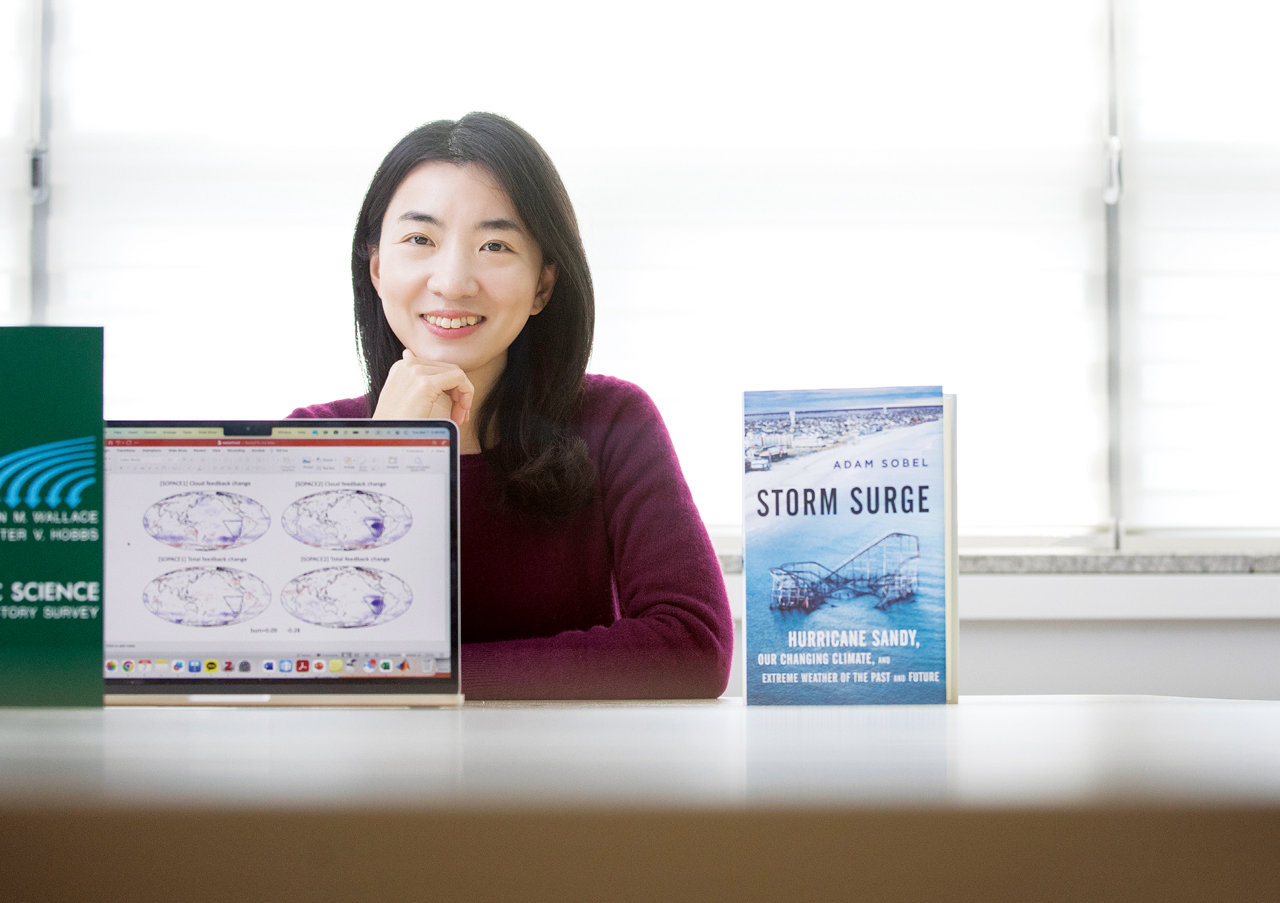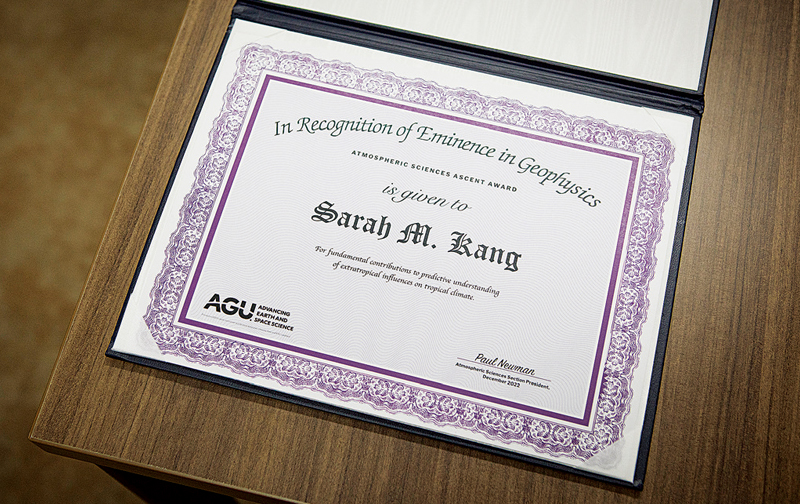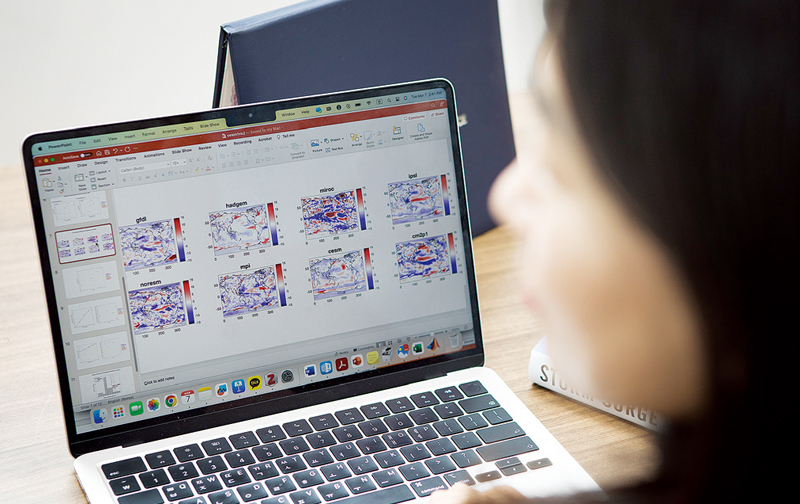
- PEOPLE 1
-
Changing the Perspectives on
Extratropics-to-Tropics
Teleconnection
본문영역
Professor Kang Sara, Department of Urban Environmental Engineering
The subject that arises most often when explaining global warming is that of ‘how many degrees the earth’s temperature may rise by if a certain amount of carbon dioxide is emitted.’ Climate models make these forecasts possible. Although climate models have been steadily developed to forecast climate change, certain unresolved errors have persisted. Professor Kang Sara started with the question, ‘Why do errors exist?’ and attracted the world’s attention by presenting research outcomes that changed the conventional perception.

Forging her own path
The experience of visiting the National Aeronautics and Space Administration (NASA) for two months each year with her father, who was an atmospheric scientist, or an anecdote about how she was attracted to trying to understand natural phenomena through mathematics and physics, perhaps because she had inherited her talent as a scientist. These are all stories about Professor Kang Sara. Her path to becoming a scientist was natural enough to wonder if her future had been pre-determined since her birth, but Professor Kang is where she is today because she made a choice without allowing anyone to push her back.
“I can't ignore my childhood experiences or the environment I've seen and learned from, but in the end, a dream can only become a reality of one is interested and has fun. I am nurturing my dream with the nourishment my father gave me.”
Professor Kang Sara, who says that she has always enjoyed calculating the weather she experiences and explaining why it happens, has focused on one subject since starting out on the path to becoming an atmospheric scientist. Even her doctoral dissertation was on ‘the teleconnection between high-latitude regions and the Tropics,’ which she researched for more than ten years.
“Many previous studies had reported that if something happened in the weather in a tropical area close to the equator, it would affect high-latitude areas such as the Antarctic and Arctic regions. On the other hand, the effect of high latitudes on the tropics was unknown. I thought there might be a correlation since the atmosphere is moving, and so I decided to prove it.”
For the first time in the world, she began to uncover the secrets of the atmospheric circulation that connects the Polar Regions and the Tropics. In 2016, she discovered that a hole in the stratospheric ozone layer in the Antarctic region had caused a change in atmospheric circulation, which affected the tropical region, and it was published as a ‘Research Highlight’ in Nature Geoscience, the most authoritative academic journal in the field of meteorology. The result overturned the existing theoretical view that global warming caused the temperature and water vapor to increase, generating torrential rain in the southern hemisphere's subtropical regions. That is how she started to forge her own path step by step.
Desire to become a top authority in her research field
Until the early 2000s, climate changes in high-latitude and tropical (low-latitude) regions were studied separately. However, Professor Kang's research, which identified the teleconnection effect of high latitudes on tropical regions, marked a new beginning in the field of climate dynamics. Her work earned considerable recognition last year when she became the first Korean scientist to receive the Atmospheric Sciences Ascent Award from the American Geophysical Union (AGU). Each year, the AGU selects about four atmospheric scientists who have demonstrated outstanding achievements between eight and twenty years after receiving their PhD.
“I think it is more honorable that the award winners are selected based on the recommendations of fellow scientists. In fact, I’ve often wondered if I was doing well since I became immersed in just one topic, unlike many scientists who conduct convergence research in multiple fields or deal with multiple research topics for many years and achieve results. What I’ve been thinking about for a long period has become a point of difference, and I’m happy that my efforts have been recognized with this award.”
Professor Kang says that although she has focused on one field, her research is ongoing because various atmospheric science problems derived from her research are also being studied. In a recent study, she built model experimental data through international collaboration in an attempt to understand the role of ocean circulation on teleconnection. Her work in this area is regarded as an outstanding achievement that has pioneered a new field of climate dynamics.
“At one time, my research faced an obstacle as the results of one published study after another showed that the effect of high latitudes on the Tropics was insignificant. They reported that the high-latitude elements were absorbed through the ocean, which reduced the effect, but I was able to verify that my research was correct through the factor of clouds. In other words, it was an opportunity for me to realize that it is necessary to study not just the atmosphere but also the ocean and clouds comprehensively. Since then, various derivative studies have also been published.”
Currently, Professor Kang is concerned that the water temperature of the tropical Pacific Ocean is getting colder even while the earth's temperature is rising. She believes that the current climate models have not been able to find the cause of this cooling phenomenon because of an error resulting from the failure to take high latitudes into account.
“I think profound reflection and consideration ultimately determine the quality and results of research. You have to keep wondering and doubting the conventional wisdom in order to move forward. In particular, since atmospheric science studies earth phenomena, we should look at it and conduct research globally.
Professor Kang has a story she always tells the students in her research team. “Posture makes the difference.” It means having wide horizons and big aspirations. It is also what she says to herself. As she is exploring her chosen field very deeply, it is her dream and aspiration to become the most authoritative scientist and world-class researcher in the field of ‘teleconnection between high-latitude and tropical regions’ in the future.
It means having wide horizons and big aspirations.



